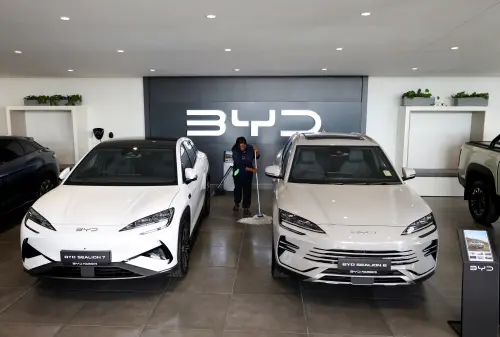Introduction
Chinese electric vehicle (EV) manufacturers, led by BYD, are rapidly emerging as formidable contenders in the race to produce affordable self-driving cars, directly challenging Tesla's established position in the market.Context
In recent developments, BYD disrupted China's smart-EV industry by offering its “God’s Eye” driver-assistance package for free, significantly undercutting Tesla's technology, which retails for nearly $9,000 in China. Taylor Ogan, an investor based in Shenzhen, noted that BYD's God’s Eye system could outperform Tesla’s “Full Self-Driving” (FSD) option.Other competitors, including Leapmotor and Xpeng, are also providing affordable vehicles integrated with advanced FSD-like technologies for around $20,000, further escalating competition in this lucrative sector. Supported by favorable government policies, Chinese firms are vying for technological advancements in the autonomous driving field.
Developments
Analyses revealed that BYD’s costs for the hardware used in their assisted-driving systems are significantly lower than those of Tesla. BYD's systems incorporate radar and lidar, while Tesla's FSD system relies solely on cameras and artificial intelligence. This pricing strategy places Tesla's market share at risk amid falling global vehicle sales.Adding to Tesla’s hurdles is the upcoming trial of autonomous robotaxis in Austin, Texas, which is part of Musk's renewed focus on the company following a tumultuous past. Despite efforts, Tesla has faced challenges from Chinese brands that not only offer lower-priced alternatives but also benefit from data training constraints imposed by local regulations.
Chinese competitors are bolstered by governmental subsidies aimed at promoting advanced driving technologies. The intense competition has fostered an environment of rapid innovation, enabling manufacturers to offer cutting-edge features while minimizing costs. For instance, Huawei has partnered with several automakers to enhance their technological capabilities.
An analysis shows that BYD's mid-tier God’s Eye system runs on superior technology and is more affordable than Tesla's FSD system. The critical sensor components are also considerably cheaper in China due to the economy of scale achieved during the recent EV boom. This cost efficiency is pivotal for BYD's market strategy, effectively enabling lower consumer prices.
Ogan emphasized that BYD has a substantial advantage in accumulating real-world driving data necessary for fine-tuning autonomous systems, giving it an edge over Tesla in the fiercely competitive Chinese market. BYD's proactive approach, including the complimentary offering of key technologies, is likely to enhance sales and further fortify its position.
